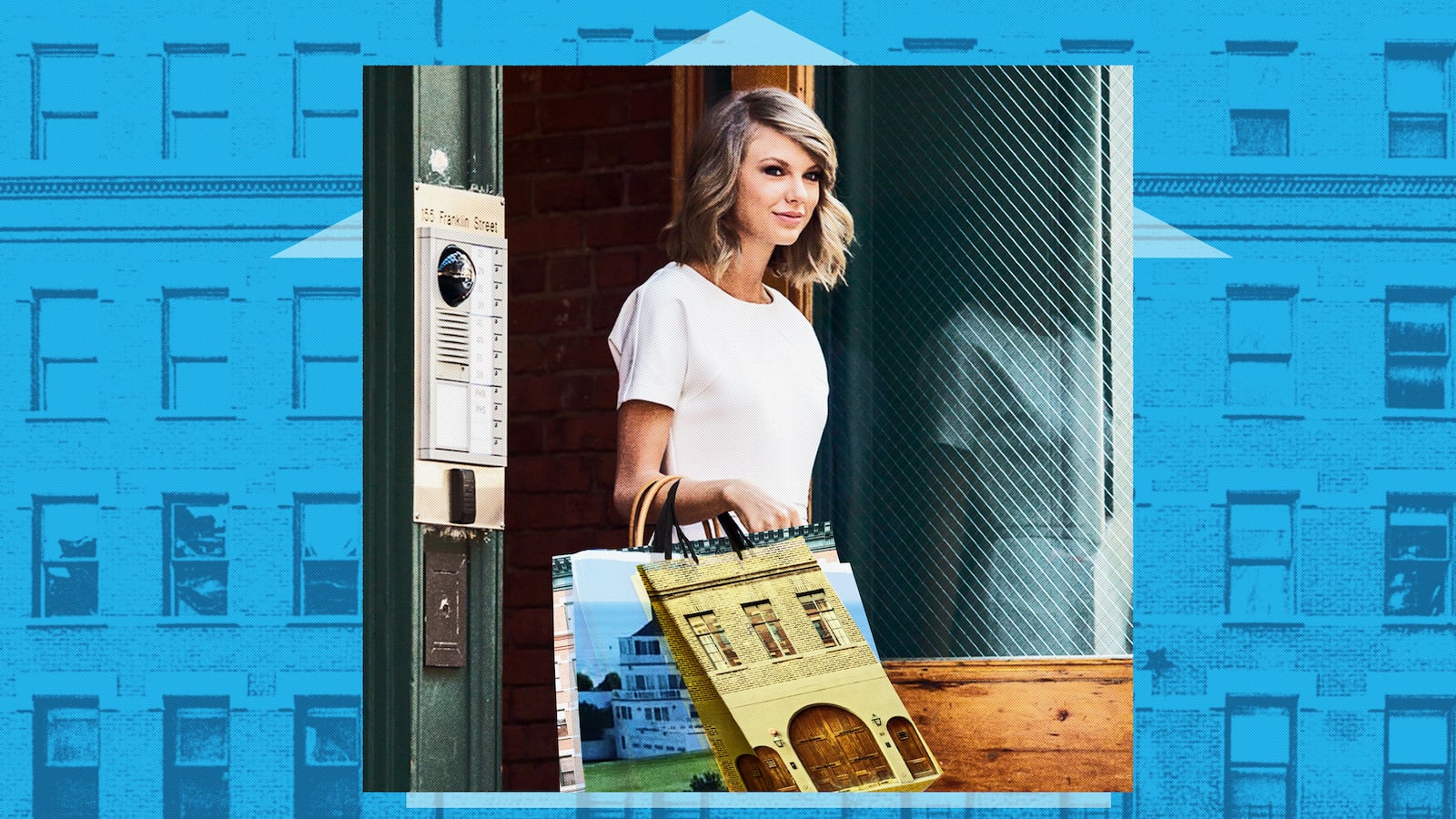Taylor Swift fans, your chance has come once more to rent a piece of history—specifically, the Cornelia Street apartment that inspired her Lover song “Cornelia Street,” which includes the lyric, “I rent a place on Cornelia Street.”
Swift briefly rented the charming West Village pied-à-terre beginning in 2016, while renovating her massive apartment in Tribeca. It was in this hallowed space (initially built as a carriage house in 1870) where, as Swift sings, she memorized “the creaks in the floor.” The going theory among Swifties is that the song documents Swift’s early romance with her ex Joe Alwyn.
In the song, Swift reveals that “if you ever walk away, I’d never walk Cornelia Street again.” Now, one month after the couple split, the apartment is back in the spotlight as its real estate broker drums up publicity in TMZ. All this can be yours, for $45,000 per month.
This is Swift’s lot in life, so to speak. Much like anything else that celebrities do these days, real estate has become subject to constant reporting. In an era when many millennials with lingering memories of marathoning Cribs now spend their time wistfully scrolling through Zillow, real estate has also become a part of celebrities’ brands.
Swift’s notoriously plush real estate portfolio—which the Wall Street Journal tallied at $150 million earlier this year—has helped tell her story for more than a decade. They’ve helped define her aesthetic and become part of her lore. Through the years, the singer has woven her homes and their own histories into her music and, conversely, used her real estate purchases to weave herself into their histories too.
Since the beginning of her career, Swift’s so-called “authenticity” has been at the heart of her detractors’ skepticism—and wealth has long played a part in sowing that mistrust. In spite of the “underdog” narrative that the singer cultivated early in her career, some critics pointed out that she was born into considerable money: Her mother is a former marketing manager, and her father, a Merrill Lynch stockbroker, descends from three generations of bank presidents, according to the New Yorker. An aptly titled 2016 post from The Ringer asked, “When Did You First Realize Taylor Swift Was Lying to You?”
It should come as no surprise, given her family history, that as Swift’s album sales rose, she began to park some of that cash into real-estate investments.
Beverly Hills (and Nashville): That’s where Taylor wants to be
Ever the industrious one, Swift made her first purchase at age 20, when the Wall Street Journal reports that she purchased her Nashville condo on Nashville’s Music Row for $2.377M in 2009.
Swift cobbled her 5,000 square-foot starter home together by purchasing two units—a construction endeavor to which she would later return, much to the consternation of some of her neighbors in Tribeca years later.
The eye-catching abode, seen in Swift’s 2020 Netflix documentary Miss Americana, was basically the godmother of grand-millennial design. Swift’s zest for something “different from everywhere else I see”—described by journalist Jody Rosen for Vulture as an “eye-popping cacophony of patterned wallpaper and fabrics”—foretold current interior design trends toward all things vintage and maximalist and helped solidify her accessible, lightly quirky girl brand.
As Swift picked out tiles and wallpapers in 2009, she described her decorative instincts as “whimsical quirky eclectic tree house.” Four years later, Rosen described the final product as a “Shabby-Chic Alice in Wonderland.”
In 2010, Swift’s star soared with Speak Now—which defied downward trends in album sales and sold 1,047,000 copies in the US in its first week. The triumph of Swift’s album ushered in a new chapter in her real estate story as well. We’ll call 2011 her “I’ve arrived” era.
That year, Swift bought her first home in Beverly Hills. In keeping with her dreamy, proto-cottagecore brand, Swift managed to find perhaps the only Cape Cod-style home in the 90210 for $3.55 million, the Journal reports. Swift also bought a $2.5 million mansion for her parents in 2011—a Greek Revival structure called “the Northumberland Estate.” (Our Tay-Tay really loves her idiosyncratic architectural styles!) A year later, Swift dropped another $1.775 million for a second house in Beverly Hills to use for guests—you know, as one does.
When Swift finally welcomed Vogue to her home for a round of “73 Questions” in 2016, she did so at her Beverly Hills estate. The wallpaper was out in full force, and apparently T-Swift keeps a VMA trophy next to her coffee maker. The garden? Stunning. The accents feel like a throwback to the days when Pier 1 was it for suburban interior design, and the lighting is warm and cozy. It was all perfectly curated, and it all screamed “Taylor Swift.”
Put together, the Nashville and Beverly Hills properties solidified Swift’s purchasing power and demonstrated what her fans and savvy critics already knew: She wasn’t going anywhere.
Taylor moves in—and out—of Cape Cod
Then came the time Swift dated a Kennedy. In August 2012, months before she released her smash album Red and six weeks into her relationship with Conor Kennedy, Swift bought a $4.9 million home on Cape Cod, across the street from the Kennedy compound. In the book The Kennedy Heirs, a friend of Conor’s said that Swift’s purchase made him nervous: “It seemed as if she was getting a little too attached, spending five million bucks on a house just to be near the guy.”
Chatter about Swift’s dating life was at its most pervasive around the time Red debuted. By then, she’d dated a string of A-listers, including Jake Gyllenhaal, John Mayer, Taylor Lautner, and Harry Styles, and woven many of them into some of her best songs.
In retrospect, Swift’s brief stint in the Cape Cod beach home—and the discussion around it—feels like a relic from the bygone era before “Blank Space,” when gossip about her relationships was as pervasive as reviews of her music. In the end, however, Swift got the last laugh on this one; as quickly as she sold her coastal pad, she still walked away with an $870,000 profit.
Miss “Taymerica”
Perhaps the most crucial real estate investment of Swift’s career so far came in 2013, when she bought her Rhode Island mansion for $17.75 million. This would become the stage for the brand-defining tradition “Taymerica.” The annual Fourth of July event first made news in 2014, thanks in part to the rise of Swift’s “Girl Squad.”
This was the time of “Bad Blood,” Mad Max-style costumes, and power in girlbossy numbers. The “Girl Squad” was Swift at her most controversial, and Taymerica was its nexus. Lena Dunham was on deck at Taymerica 2014, as were Gossip Girl star Jessica Szohr, Emma Stone, Andrew Garfield, “You & I” singer Ingrid Michaelson, and Swift’s The Giver co-star Odeya Rush.
The parties seemed, in a way, like Swift’s armor against the constant chatter of her critics—photographic evidence that some people, at least, liked her just fine, thankyouverymuch!
Swift’s Rhode Island home, also called Holiday House, was built in 1930 and is the highest on Watch Hill—which makes it the perfect backdrop for enviable, narrative-setting ’grams. It was here in 2016 that we saw Tom Hiddleston in an “I <3 TS” tee—and also an utterly miserable-looking Ryan Reynolds on the porch.
The Rhode Island estate might carry deeper meaning for Swift than any other property in her portfolio. The house’s former owner—high-society socialite, philanthropist, and artist Rebekah Harkness—inspired Swift’s folklore song “The Last Great American Dynasty.” The song draws parallels between the scrutiny Swift and her pals received during their time at Holiday House and the judgment Harnkess drew in her day.
Welcome to New York
Way before folklore, however, came Swift’s Manhattan girl phase. (Remember when she got a new job as a tourist ambassador and welcomed herself to New York?) In spring 2014, Swift rode in on the chilly breeze and dropped $19.9 million on two penthouses in Tribeca’s Sugar Loaf building. (Her cat Meredith Grey seemed to love the view.) Put together, the penthouses—previously owned by Lord of the Rings director Peter Jackson—total 8,018 square feet. It was from this abode that Swift once famously exited in a large box.
The Journal reports that, in 2017, Swift expanded her Tribeca real estate portfolio by buying an additional $18 million townhouse and, later, an adjacent $9.75 million apartment. When Swift bought the apartment, some neighbors in the area expressed their irritation to the New York Post. “Franklin Street has a history of being an apocalypse of construction,” one source said. “When even one lane is blocked off, it can cause chaos.”
Nevertheless, she persisted.
Taylor goes Hollywood
By then, it was time for Swift’s close-up: In 2014, the rumor mill started churning that Swift was itching for her big-screen debut—and an Oscar. She’d auditioned for Tom Hooper’s Les Miserables—which debuted in 2013—and Twilight: New Moon director Chris Weitz said last year that she’d requested a part in the 2009 vampire film as well. Speaking with the Philadelphia Inquirer in 2012, Swift claimed she’d been reading scripts for five years and working with an acting coach as well.
Cue Swift’s MGM era—otherwise known as the time she bought the Old Hollywood estate that legendary Hollywood producer Samuel Goldwyn of Metro-Goldwyn-Mayer built for $25 million, restored it, and got it certified as a historic landmark.
Also in 2015, Swift dropped a dreamy video for her 1989 single “Wildest Dreams”—which nods heavily toward MGM’s 1953 romance Mogambo alongside other influences.
Swift sold her first two Beverly Hills homes in 2018 and made a profit on each, the Journal reports. One of the estates had faced multiple security incidents prior to the sale.
In 2016, during construction on her Tribeca penthouse(s), Swift began renting the Cornelia Street apartment. She rode out part of the pandemic in Primrose Hill with Joe Alwyn, but Manhattan seems to have captured more of their glow. So powerful is the singer’s lore that in the wake of her break-up with Joe Alwyn, fans have been paying visits to the building where she no longer lives in remembrance. Swift might never walk Cornelia Street again, but her fans likely will for years to come—as will whoever can cough up the five-figure rental price.








